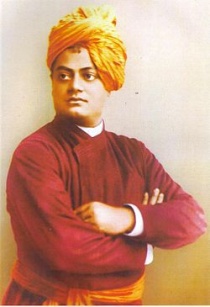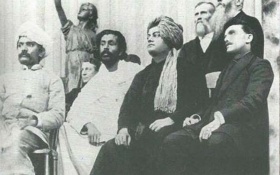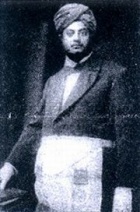Vivekananda: Difference between revisions
No edit summary |
|||
| (One intermediate revision by the same user not shown) | |||
| Line 2: | Line 2: | ||
'''ARTICLE UNDER CONSTRUCTION'''<br> | '''ARTICLE UNDER CONSTRUCTION'''<br> | ||
[[File:Swami Vivekananda 1893.jpg|right|210px|thumb|Swami Vivekananda in 1893]] | [[File:Swami Vivekananda 1893.jpg|right|210px|thumb|Swami Vivekananda in 1893]] | ||
'''Swami Vivekananda''' (12 January 1863 – 4 July 1902) was an Indian Hindu monk and disciple of Ramakrishna. He introduced [[Hinduism]] at the [[World's Parliament of Religions (1893)|World's Parliament of Religions]] in Chicago in 1893, and founded the Vedanta Society of New York in 1894. | '''Swami Vivekananda''' ([[January 12|12 January]] 1863 – [[July 4|4 July]] 1902) was an Indian Hindu monk and disciple of Ramakrishna. He introduced [[Hinduism]] at the [[World's Parliament of Religions (1893)|World's Parliament of Religions]] in Chicago in 1893, and founded the Vedanta Society of New York in 1894. | ||
== Early life == | == Early life == | ||
| Line 56: | Line 56: | ||
[[Category:Lecturers|Vivekananda]] | [[Category:Lecturers|Vivekananda]] | ||
[[Category:Hindus|Vivekananda]] | [[Category:Hindus|Vivekananda]] | ||
[[Category:Advaita Vedanta|Vivekananda]] | |||
[[Category:Writers|Vivekananda]] | [[Category:Writers|Vivekananda]] | ||
[[Category:Educators|Vivekananda]] | [[Category:Educators|Vivekananda]] | ||
Latest revision as of 13:41, 15 August 2024
ARTICLE UNDER CONSTRUCTION
ARTICLE UNDER CONSTRUCTION
Swami Vivekananda (12 January 1863 – 4 July 1902) was an Indian Hindu monk and disciple of Ramakrishna. He introduced Hinduism at the World's Parliament of Religions in Chicago in 1893, and founded the Vedanta Society of New York in 1894.
Early life
Education and monastic life
Travels in the West
World's Parliament of Religions (1893)
Lecture tours
Accoriding to many accounts, Swami Vivekananda was a riveting speaker, whether talking to a small group or a huge audience. Margaret Elizabeth Noble, later known as Sister Nivedita, described him as "A majestic personage, clad in a saffron gown and wearing a red waistband, sat there on the floor, cross-legged. As he spoke to the company, he recited Sanskrit verses in his deep, sonorous voice."[1]
Travels in India
Theosophical Society interactions
Vivekananda and the Theosophical Society shared many ideals and goals, but misunderstandings and distrust marred the relationship.
Annie Besant, on hearing the Swami speak at the Parliament, wrote appreciatively:
A striking figure, clad in yellow and orange, shining like the sun of India in the midst of the heavy atmosphere of Chicago, a lion head, piercing eyes, mobile lips, movements swift and abrupt - such was my first impression of Swami Vivekananda. All was subdued to the exquisite beauty of the spiritual message which he had brought, to the sublimity of that matchless truth of the East which is the heart and the life of India, the wondrous teaching of the Self. Enraptured, the huge multitude hung upon his words; not a syllable must be lost, not a cadence missed! "That man, a heathen!" said one, as he came out of the great hall, "and we send missionaries to his people! It would be more fitting that they should send missionaries to us!"[2]
Vivekananda's influence would not have been possible without the pioneering work of the Theosophical Society. Scholar E. De Michelis wrote that Vivekananda--
... Capitalized on the interest in Indian religions generated by the academic study of religion and, even more so, by the popularization of Oriental ideas carried out by occultist groups such as the Theosophical Society.[3]
Freemasonry
Vivekananda was a Freemason, according to the website of Shillong Freemasons Lodge #61.[4]
Death
Writings and published lectures
The Union Index of Theosophical Periodicals lists 31 articles by or about Swami Vivekananda.
Additional resources
- Swami Vivekananda in Wikipedia.
- Bibliography of Swami Vivekananda in Wikipedia lists dozens of biographies and commentaries on Swami Vivekananda.
- Vivekananda Vedanta Network website.
- Vivekananda Natal Horoscope at Khaldea.
Video
- America's First Guru. PBS. May, 2024. 1 hour 28 minutes. Feature-length documentary about Vivekananda.
Notes
- ↑ This phrase is often quoted inbooks and articles about Nivedita, but without attribution. One example is Mother and Sri Aurobindo website and another is "Cradle Tales of Hinduism".
- ↑ David Frawley, "Modern India Owes a lot to Annie Besant" Dailyo.in March 10, 2015.
- ↑ Elizabeth De Michelis, A History of Modern Yoga, (New York, NY: Continuum, 2008), 154.
- ↑ "Famous Indian Freemasons," Lodge 61 website.


